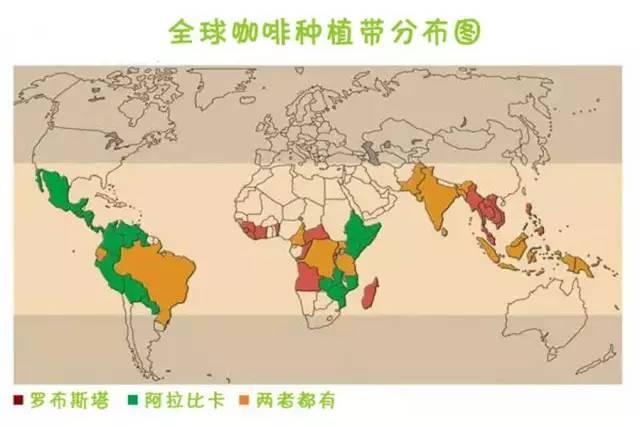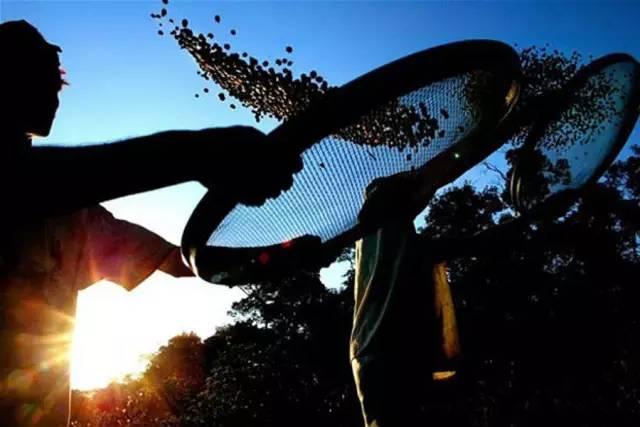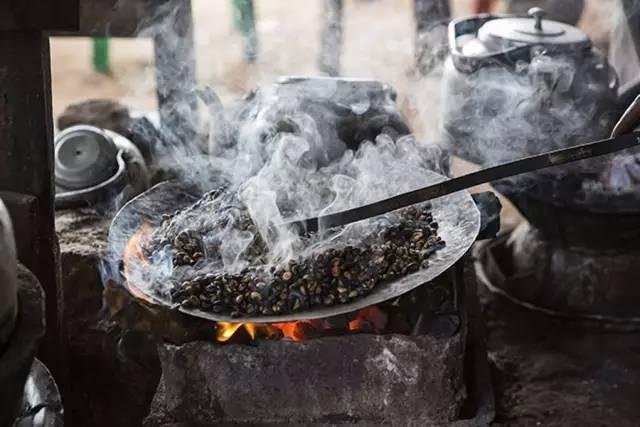Do not know the top 10 coffee bean producers? You drank all your coffee for nothing.
Coffee can be said to be a favorite drink for white-collar workers in modern cities, but do you know which countries are the real big coffee producers? Is it Italy, which is famous for its Italian Espresso, or the United States, where Starbucks sweeps the world? Neither! The International Coffee Organization (International Coffee Organization) has announced the top 10 countries of origin of coffee beans in the world, some of which have not even heard of the name of the country, and instantly found that the previous coffee has been drunk for nothing.

Note: from the point of view of geographical location, coffee beans and grapes are planted in opposite areas. Countries rich in coffee beans are mostly located near the equator, and mainly grow Robusta and Arabica.
1. Brazil

For more than 100 years, Brazil, a big South American country, has been the world's largest coffee producer, known as the "coffee kingdom". The caffeine produced here is famous in the world for its high quality and strong taste, so it is also the world's largest coffee exporter. Coffee was first introduced to Brazil in 1727. Because it is located in the tropics and subtropics, the unique geographical and climatic conditions are very suitable for growing coffee trees, coupled with cheap labor, so the coffee growing industry flourished rapidly. During the 19th century, coffee cultivation in Brazil spread almost all over the country, and reached its peak in the 1920s, accounting for 80% of the world's total coffee, which declined later with the widespread cultivation in other countries. at present, the total planting volume is still 27000 square kilometers.
Brazil is different from other countries in the processing of coffee beans, because Brazilians often use the drying method (without cleaning), and coffee berries are usually dried in the sun and then sorted; there are also some coffee beans processed by semi-washing or honey treatment. Brazil produces not only coffee powder made from roasted coffee beans, but also instant coffee. Although there are many kinds of coffee, it is very suitable for public taste. It is worth mentioning that Brazil is one of the few countries that both produce and consume a lot of coffee, which shows how much Brazilians love coffee.
2. Vietnam

Vietnam, a Southeast Asian country with a hot and humid tropical climate, is an ideal home for coffee trees, so its output ranks second all the year round. Just like the familiar Vietnamese coffee, the iconic way to drink coffee here is sweetened condensed milk, so it tastes sweet, which is very popular in many places, and now some people are used to adding ice cubes to it. However, some people think that Vietnam is dominated by Robusta varieties, which will have a heavy bitter taste, which may also be an important reason why they add sugar condensed milk to their coffee. Despite the steady development of Vietnamese coffee, which has been affected by war in history, its output has already exceeded one million, from 6,000 tons in 1975 to the second largest in the world.
3. Colombia

Juan? Valdez
Colombian coffee is also well-known around the world and is one of the few individual coffees sold in the world under the name of the country, thanks in part to the promotion role of the coffee growers' association. They built a guy called Juan? Juan Valdez's image as a coffee farmer has made a great contribution to the development of local coffee. In the past, Colombia has been the second largest coffee producer, falling to third place with the rise of Vietnam and the impact of climate change. But still does not affect the status of Colombia in the hearts of coffee lovers, the coffee here taste mild and balanced, not as strong as Brazilian coffee, with a sweet fragrance, low-key and elegant.
4. Indonesia

When it comes to Indonesia, we have to mention the civet coffee here, which is the so-called Kopi Luwak in many people. This coffee, which is claimed to be one of the most expensive in the world, is processed by civets after eating ripe coffee fruit, excreted by the digestive system and extracted from cat droppings. Because the civet will selectively eat the sweetest coffee berries in the process of eating, this itself is a kind of benign natural screening, and then through the action of gastric juice, there is a difference between the coffee beans excreted from the body and ordinary beans. The coffee produced in this way is often better to drink and is very popular in the international market. Since the output is very small, only 500 kilograms a year, it is not surprising that it is sold at a high price. Of course, Indonesia's fourth place is certainly not due to Kopi Luwak, after all, its production is limited. In fact, Indonesia is a country that emphasizes output rather than quality, because the local climate is very suitable for growing cheap and easy-to-grow Robusta varieties, which makes the output so considerable.
5. Ethiopia

The traditional roasting technology of coffee beans in Ethiopia
Ethiopia is the birthplace of Arabica coffee beans that are popular all over the world. The coffee production here has a long history and has a rich coffee culture. As early as 1100 years ago, a shepherd found that sheep became extremely excited after eating coffee beans by mistake. Since then, the refreshing function of coffee has gradually become familiar to people. Ethiopia's Yirgacheffe coffee is very well-known, but also synonymous with local boutique coffee, with a strong and complex aroma. Yejia Xuefei was originally a sub-producing area, which was independent from the large producing area because of its outstanding flavor, and was unanimously sought after by experts.
6. India

Unlike most countries, Indian coffee trees are grown in shade and are not exposed to direct sunlight, so they taste exquisite. Usually, in India, coffee trees are often grown with cardamom and cinnamon trees, so the coffee produced here often has a spicy taste and aroma. India is also different from other coffee producing countries, that is, coffee is not popular here, most of the coffee is exported, the main target market is Europe and other places, of course, Indian coffee consumption is also on the rise.
7. Honduras

Honduras is located near the Caribbean Sea, where the mountain terrain is particularly prominent, suitable for coffee production, coffee beans are also an important export of the country. However, in fact, the awareness of coffee in the market is not high. Apart from the fact that the country itself is not well-known internationally, they also lack representative coffee brands. Another reason is that the coffee beans here are mostly used for blending, so they are rarely known by the general public. In fact, this seemingly unpopular coffee country is the largest coffee producer in Central America.
8. Uganda

Like Honduras, Uganda is a relatively strange country to our people, and it is not well-known in the coffee world, but this country is a big coffee exporter in Central Africa, and another popular quality in the world, Robusta, comes from the Kibale Forest forest here. In the past, the coffee industry in Uganda did not develop well under the control of the government; since the introduction of private ownership, the industry has recovered rapidly. Ugandan coffee beans are generally strictly screened to ensure their quality and have a delicate taste and unique flavor after being made into coffee.
9. Mexico

Mexico is famous for producing high-quality Arabica coffee beans, which have large particles, strong aroma and sweet and sour taste, and most of them are exported to the United States. Due to the development of the coffee industry, it has provided more jobs and sources of income for the local people. As drinkers know, Mexico is famous for producing tequila (Tequilla), and some daring people even add tequila to their coffee.
10. Guatemala

Guatemala, which borders Mexico, was the largest coffee producer in Central America until 2011 and was gradually replaced by Honduras. Guatemala Antigua Coffee (Antigua) is an aristocratic coffee with a rich sweet and sour taste and a fascinating smoky taste, which seems to emphasize its sense of mystery. Some people say that you can see a wonderful story in a cup of Guatemala Antigua coffee with a unique smoky smell, about the wisdom of the Mayans who once existed in this land.
Important Notice :
前街咖啡 FrontStreet Coffee has moved to new addredd:
FrontStreet Coffee Address: 315,Donghua East Road,GuangZhou
Tel:020 38364473
- Prev

In addition to literature and art, opening a coffee shop also requires strategy.
Many coffee shop operators are themselves a literary and tasteful person, coupled with the characteristics of the coffee shop itself and the literary and artistic commonness of the customer group, so more coffee shops are very literary and artistic. However, literature and art alone is not enough, you need more strategy to run a coffee shop. First, the product must be customer-oriented, not driven by literature and art to satisfy oneself and
- Next

Seven skills of coffee brewing
1. Filter paper brewing is the easiest way to grind: the kettle for medium and fine brewing should be selected with a fine mouth. Hot water can be injected vertically, and the pot is filled with 7-8 minutes of hot water. When boiling water, pour slowly when the number of coffee is small, and pour faster when the number of coffee is large, so that strong coffee can be brewed. Brewing step: bend the special filter paper seal line interactively and put it in the drip coffee pot.
Related
- Beginners will see the "Coffee pull flower" guide!
- What is the difference between ice blog purified milk and ordinary milk coffee?
- Why is the Philippines the largest producer of crops in Liberia?
- For coffee extraction, should the fine powder be retained?
- How does extracted espresso fill pressed powder? How much strength does it take to press the powder?
- How to make jasmine cold extract coffee? Is the jasmine + latte good?
- Will this little toy really make the coffee taste better? How does Lily Drip affect coffee extraction?
- Will the action of slapping the filter cup also affect coffee extraction?
- What's the difference between powder-to-water ratio and powder-to-liquid ratio?
- What is the Ethiopian local species? What does it have to do with Heirloom native species?

